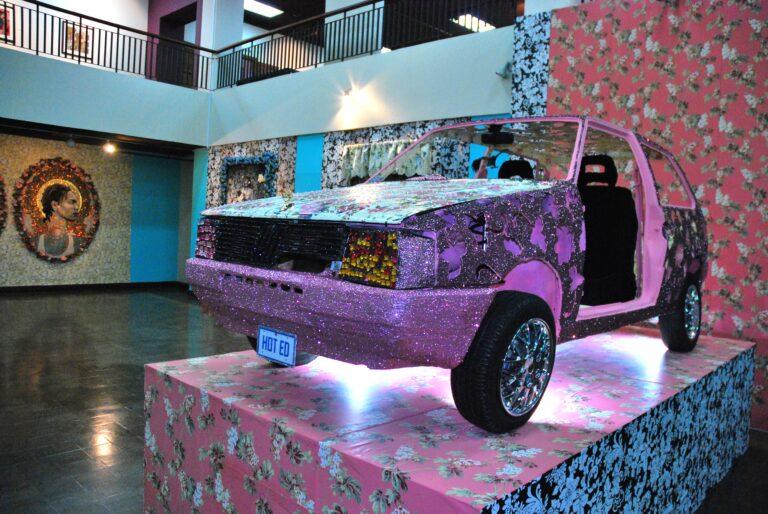Jamaica’s colonial monuments: Neglect as iconoclasm – Part 2

Last week, we looked at the Queen Victoria Statue in Kingston, as an example of how Jamaica has dealt with colonial statues and monuments. My second example is the Columbus statue in St Ann’s Bay. The statue dates from 1957, just a few years before Jamaica’s independence in 1962, and the artist is not documented. The statue’s date illustrates that most Columbus monuments in the Caribbean region are of relatively recent date and related to efforts to insert Columbus and the perceived civilizational benefits he brought to the region more actively into the public consciousness, as a sort of last gasp of the rhetoric of colonialism. Several of these are also related to efforts to position the legacy of Columbus as a tourist attraction.
As such memorials go in the Caribbean, the St Ann’s Bay Columbus is a rather modest one. The statue stands, a mere 6 feet 6 inches tall and on rather awkward conical base that is taller than the statue itself, in a small park that doubles as a traffic median on the outskirts of the town. It looks rather forlorn and derelict there. A few weeks ago, I asked my students at the Edna Manley College if they knew where in the island the Columbus statue was. Of the nearly twenty students present in class, who are from all over the island, nobody was able to answer. The instructive reality is that very few people in Jamaica know or care about this statue and this, remarkably, even includes the relevant authorities. About ten years ago, while I served as the director of the National Gallery of Jamaica, I received a call from my colleague at the Jamaica National Heritage Trust to ask me if I knew who the owner of the Columbus statue was. I was frankly taken aback, as I had always assumed that this would be the Heritage Trust. It turns out, however, that the Columbus statue was a private initiative, and the statue is not included on the list of monuments and sites on the Heritage Trust website.
From what I have been able to reconstruct thus far, it appears that the statue may have been funded and commissioned by Kaiser Bauxite, an American company which was involved in bauxite mining, processing, and shipping in Jamaica from the mid-1940s to 2004. That the statue was unveiled by the American Consul to the Jamaica certainly suggests that it was an American initiative. Kaiser, which operated the bauxite and alumina harbour facilities near to Discovery Bay, the presumed landing place of Columbus in Jamaica in 1494, also funded the Columbus Park, a small open-air museum that is located near the Puerto Seco bauxite harbour. The park, which was a popular tourist attraction and rest stop along the North Coast Highway for many years, is now derelict and closed to the public. It is unclear whether there are any active redevelopment plans or whether the Columbus narrative is even still marketable in Jamaica today.
That American interests would have involved themselves in trying to reinforce the memorialization of Columbus in Jamaica has many ironies of its own, related to American political and economic imperialism in late colonial and independent Jamaica. A plaque at the site informs us that the statue and site were renovated in 1999, with support from the Spanish Government this time, but the Columbus statue and site are again severely neglected. Plants are sprouting from its base, probably brought there by birds, and there are signs of further plant growth on the statue’s head. There is evidence that the small park in which the statue is located is inhabited by a homeless person. The fence around the park was severely damaged in a car accident, obviously some time ago, and has not been repaired.
There were some efforts around Columbus Day last year to start a campaign for the statue’s removal but this, too, appears to have been met with indifference although there is now a Black Lives Matter graffiti on the base. As such graffiti go, however, it is a rather timid and ineffectual intervention. All in all, it is obvious that this statue is of no consequence in Jamaican life and allowing it to be taken back by nature, and overrun by garbage, may be a potent form of poetic justice, which is just as powerful as any take-down or relocation of the statue would be.
Next week, we will conclude this series of articles with the Rodney Memorial in Spanish Town.
Dr Veerle Poupeye is an art historian specialized in art from the Caribbean. She lectures at the Edna Manley College of the Visual and Performing Arts in Kingston, Jamaica, and works as an independent curator, writer, researcher, and cultural consultant. Her personal blog can be found at veerlepoupeye.com.






